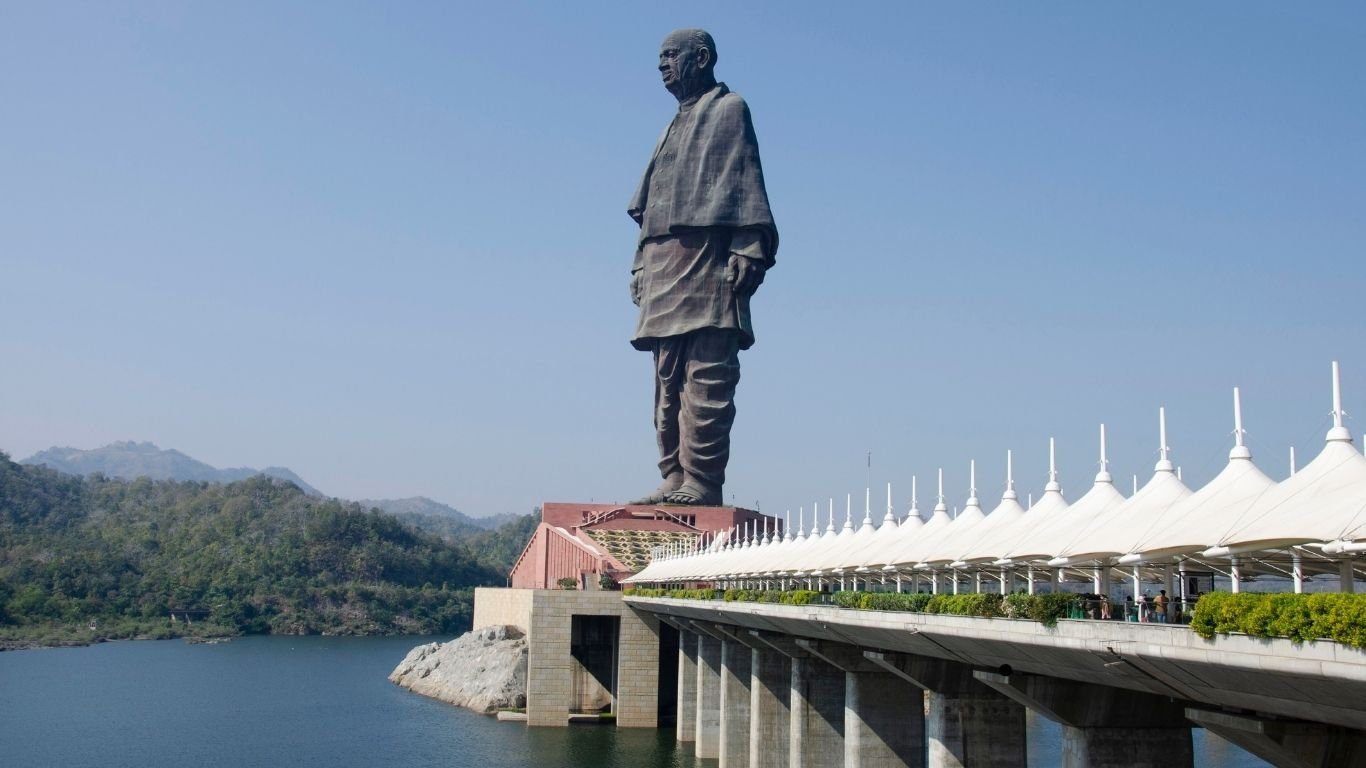The Statue of Unity stands as a monumental testament to the power of unity, resilience, and national pride. Located in Gujarat, India, this magnificent statue honors the legacy of Sardar Vallabhbhai Patel, a key figure in the unification of India after independence. Standing at an awe-inspiring height of 182 meters, it is not only the world’s tallest statue but also a symbol of India’s enduring strength and spirit.
The Statue of Unity is more than just a statue; it is a living embodiment of the power of unity that shaped India into the country it is today. This article delves into the importance of this remarkable landmark, examining its historical background, architectural excellence, and the cultural and social influence it has both on India and globally.
The Vision Behind the Statue of Unity
The Statue of Unity was conceived as a homage to Sardar Vallabhbhai Patel, one of India’s most esteemed leaders. His leadership played a crucial role in uniting the 565 princely states into one unified nation, and this statue serves as a reminder of his dedication to the cause of national integration.
Celebrating Sardar Patel’s Legacy
The idea behind the Statue of Unity was not only to honor Patel’s contributions but also to inspire future generations to value the power of unity. The monument serves as a representation of strength, resilience, and the essence of India’s unity, embodying Patel’s vision of a united nation.
National Pride and Unity
The Statue of Unity is a monumental structure that brings together people from all walks of life, fostering a sense of pride and unity. It emphasizes the significance of teamwork in the process of nation-building.
The Construction and Design of the Statue of Unity
The construction of the Statue of Unity was an ambitious project that took over 33 months to complete. Designed by renowned sculptor Ram V. Sutar, the statue was constructed by Larsen & Toubro and cost approximately ₹2,989 crore (around $425 million). The Statue of Unity stands on a 20,000-square-meter plaza, with a 153-meter-high viewing gallery that provides panoramic views of the surrounding landscape, including the Sardar Sarovar Dam and the Narmada River. The design is a blend of modern technology and traditional craftsmanship, showcasing an intricate steel frame and bronze-like coating, which not only enhances its durability but also adds to its aesthetic appeal.
The Significance of the Statue of Unity as a Symbol of Strength and Unity
At its essence, the Statue of Unity represents both unity and strength. The legacy of Sardar Vallabhbhai Patel, who united the diverse and fragmented states of India, is permanently honored through this monumental structure. The statue serves as a tribute to his leadership and unwavering dedication to creating a unified nation. The sheer scale of the statue is a manifestation of the power that comes from unity, and it serves as an inspiration for individuals and nations alike. The Statue of Unity is a call to come together, to embrace strength in diversity, and to work collectively for a brighter, more unified future.
Must Read : www.yoursvp.com: Revolutionizing Event Planning with Ease
Cultural and Social Impact of the Statue of Unity
The Statue of Unity has made a significant cultural and social impact, both locally and nationally. Here are some key contributions:
- Boost to Tourism: The statue attracts millions of visitors each year, becoming a major tourist destination in India. It has bolstered the local economy through increased tourism and related activities.
- Promoting National Unity: The Statue of Unity symbolizes national unity, bringing people from diverse backgrounds together to celebrate India’s strength and resilience.
- Cultural Education: The monument features a museum and an exhibition hall, educating visitors about the life of Sardar Vallabhbhai Patel and his role in shaping modern India.
- Community Development: Local communities around the statue benefit from new job opportunities and infrastructure improvements, fostering social growth and inclusivity.
The Statue of Unity stands as a cultural landmark and a driving force for social transformation.
Environmental and Economic Impact of the Statue of Unity
Situated near the Sardar Sarovar Dam, a crucial resource for the people of Gujarat, the statue holds both environmental and economic importance.The monument itself has played a significant role in promoting environmental sustainability. It was constructed using sustainable materials and incorporates eco-friendly features such as solar power and rainwater harvesting systems. Additionally, the development of the Statue of Unity has brought attention to the surrounding region, sparking investments in infrastructure, tourism, and local businesses. This economic boost has helped improve the livelihoods of people living in the vicinity of the statue, making it an important driver of development.
The Role of Technology in the Statue of Unity
The Statue of Unity showcases the innovative use of cutting-edge technology in both its construction and ongoing maintenance. From the initial design to the final execution, the project incorporated advanced tools such as 3D modeling, robotics, and state-of-the-art material engineering. These technologies ensured that the monumental scale of the statue was built with incredible precision. Additionally, the design integrates modern surveillance and security systems to guarantee visitor safety and the preservation of the monument. The Statue of Unity serves as a prime example of how contemporary technology can be harnessed to create a lasting, impactful legacy while maintaining historical and cultural integrity.
The Global Recognition of the Statue of Unity
The Statue of Unity has earned immense recognition not only within India but globally as a symbol of unity and strength. Standing as the tallest statue in the world, it has drawn comparisons with other monumental structures like the Spring Temple Buddha in China and the Christ the Redeemer statue in Brazil. The Statue of Unity has emerged as a symbol of national pride for India, motivating people worldwide to understand the significance of unity in overcoming obstacles. Its growing global acknowledgment also sets the stage for future projects that promote cultural preservation and global unity.
The Symbolism of Unity in the Statue of Unity
At its core, the Statue of Unity represents far more than just the image of a great leader. It embodies the spirit of unity that Sardar Patel dedicated his life to achieving. Patel’s monumental role in integrating the princely states of India into one cohesive nation is immortalized through this statue. The Statue of Unity stands as a powerful reminder that despite the nation’s diverse languages, cultures, and religions, India has remained united. It inspires us to recognize the power of unity, motivating actions that promote a cohesive and peaceful future.
The Statue of Unity as a Tourist Destination
The Statue of Unity is rapidly becoming one of India’s top tourist destinations, drawing visitors from around the world. Travelers come not only to admire its sheer height but also to learn about the legacy of Sardar Vallabhbhai Patel. Beyond the statue, visitors have the opportunity to discover nearby attractions such as the Sardar Patel Zoological Park, the Valley of Flowers, and the Sardar Sarovar Dam. The growing tourism infrastructure, including hotels, transport services, and recreational activities, ensures that visitors have a rich and immersive experience when visiting the Statue of Unity.
The Future of the Statue of Unity
The Statue of Unity is set to evolve, continuing to inspire future generations. Some key aspects of its future development include:
- Integration of Modern Technologies: Advanced technologies such as augmented reality and interactive displays will be incorporated to enhance visitor experiences.
- Continued Promotion of Unity: As India progresses, the Statue of Unity will remain a symbol of national unity, reflecting India’s strength and resilience.
- Cultural and Economic Development: Future developments around the statue are expected to boost the local economy further, creating more opportunities for cultural tourism and community engagement.
- Adapting to Changing Times: As technology and infrastructure evolve, the statue will continue to adapt, ensuring its relevance as a beacon of India’s values and principles.
The Statue of Unity is poised to continue as a vibrant and ever-evolving symbol of unity, pride, and advancement for many years ahead.
Conclusion
The Statue of Unity stands as a monumental testament to unity, strength, and the enduring power of collective action. As the world’s tallest statue, it is not just an architectural marvel but also a symbol of India’s cultural heritage and resilience. Celebrating the legacy of Sardar Vallabhbhai Patel, it serves as a constant reminder that unity is key to overcoming challenges and achieving greatness. Whether visiting to admire its grandeur or reflecting on the history it represents, it leaves a profound impact on all who experience it.
Thanks for visiting Globalexpressinfo.com. Don’t forget to share it on Twitter.






